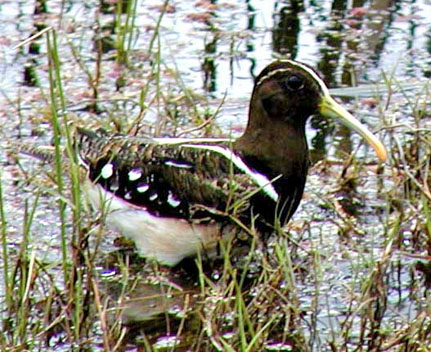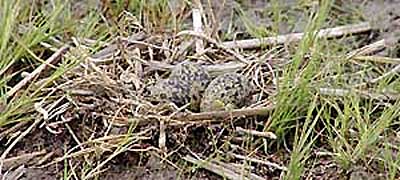| |
PAINTED-SNIPES Rostratulidae |
- 3 species in the Old World and in South America
- DR personal total: 1 species (33%), 1 photo'd
|
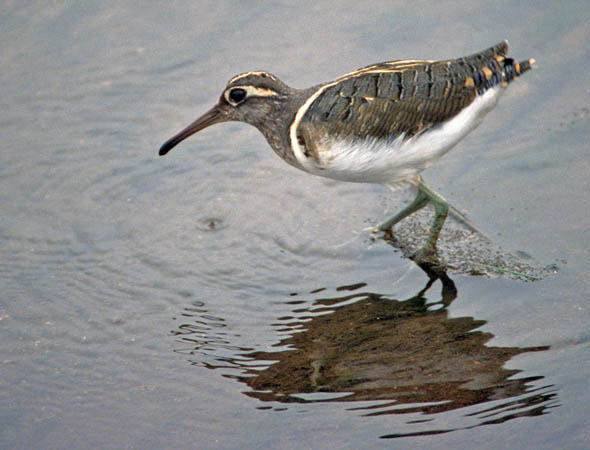 The Painted-Snipes are a very small family of shorebirds that only superficially resemble typical snipes. They are closely more related to jaçanas than to typical shorebirds. The family is composed of three species: Greater Painted-Snipe and Australian Painted-Snipe (in genus Rostratula) and the South American Painted-Snipe (in genus Nycticryphes). The Painted-Snipes are a very small family of shorebirds that only superficially resemble typical snipes. They are closely more related to jaçanas than to typical shorebirds. The family is composed of three species: Greater Painted-Snipe and Australian Painted-Snipe (in genus Rostratula) and the South American Painted-Snipe (in genus Nycticryphes).
Greater Painted-Snipe (left) has a wide range over the warmer parts of the Old World, including sub-Saharan Africa and much of tropical Asia, including the Greater Sundas. It, and the similar Australian Painted-Snipe, are sexually dimorphic with the brighter colored birds being females, and the cryptically colored birds with the big buffy wing spots being males. This bird (left) is a male, perhaps young. This reversal of the usual pattern in sexually dimorphic species is consistent with the birds' life history. It is the female that does the courting, and it is the male that incubates the eggs and rears the young. In this aspect the Greater Painted-Snipe recalls the "role reversals" found in phalaropes, Plains-Wanderer, and some buttonquail. |
Painted-Snipe are birds of lowland marshes, swampy open country, and grassy wetlands, and use such sub-habitats as marshy edges of ponds and slow-moving rivers, rice paddies, and muddy agricultural fields. All species are omnivorous, consuming invertebrates and their larvae, including insects, snails, crustaceans, and earthworms. All are uncommon to rare, and are nomadic in occurrence, moving with changes in water levels, including the natural cycles of drought. All are weak fliers on rounded wings rather than explosive and swift flying waders as are typical Gallinago snipes. Although largely solitary, some populations of painted-snipe breed semi-colonially.
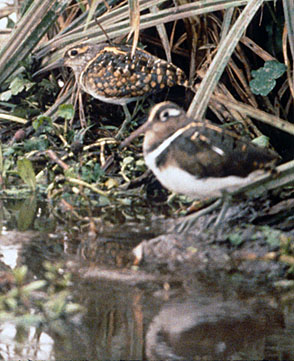 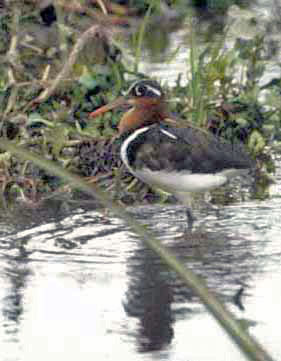 The Greater Painted-Snipe has a polyandrous lifestyle. Photos by Ed Harper (far right) shows both a male (with heavy wing spots) and a female (foreground with a rusty chest, and also the photo near left) The female courts a male and lays eggs which he will incubate. She then abandons him to go court other males. Due to these habits, nests are often close together although the male will defend a small territory from other males. Although the female takes a passive role in chick-care, she may stay in a territory and help defend it. This brief summary of breeding biology is from Kirwan (1996) who indicates that there is much that is not known about the basic biology of painted-snipes. In parts of southern Africa, for example, a monogamous system has been observed in Greater Painted-Snipe in which the female does help in nest building and raising the young. The Greater Painted-Snipe has a polyandrous lifestyle. Photos by Ed Harper (far right) shows both a male (with heavy wing spots) and a female (foreground with a rusty chest, and also the photo near left) The female courts a male and lays eggs which he will incubate. She then abandons him to go court other males. Due to these habits, nests are often close together although the male will defend a small territory from other males. Although the female takes a passive role in chick-care, she may stay in a territory and help defend it. This brief summary of breeding biology is from Kirwan (1996) who indicates that there is much that is not known about the basic biology of painted-snipes. In parts of southern Africa, for example, a monogamous system has been observed in Greater Painted-Snipe in which the female does help in nest building and raising the young.
|
|
The South American Painted-Snipe (left, in a photo by John & Karen Shrader) ranges throughout the southern "cone" of South America. It may not sexually dimorphic and perhaps does not have a "role-reversal" breeding strategy, although much is still to be learned about this enigma. The photograph is a bird (probably a male) near a nest (the eggs in nest are at lower left).
Some books place all species in the same genus, but Kirwan (1996) gives some good reasons why this New World species should each be assigned to a unique monotypic genera. Among other things, the two birds differ in that the South American species has webbed toes, and that the female in the Old World birds has a unique crop that is not used for digestion but has a role in courtship (it acts as a resonance chamber during the species' prolonged vocal displays). The South American bird also has a more decurved bill over the distal half, as is apparent in this photo.
The Australian Painted-Snipe Rostratula australis is a recent split from Greater Painted-Snipe. It differs in plumage — possibly important in displays? — and biometrics, and is genetically distinct; Baker et al. (2007). It has been on the decline in Australia, and is now considered an Endangered species (Lane & Rogers 2000). |
|
| Like typical snipes, the painted-snipes are skulking and retiring, and therefore often hard to see. Traditionally placed near the shorebirds (Scolopacidae), the true relationships of Painted-Snipe was not known until recently. Sibley & Ahlquist (1990) placed them near the jaçanas and sheathbills. Molecular research in this century place the Painted-Snipes [Rostratulidae] sister to the Jaçanas [Jacanidae] within a clade that also includes Plains-wanderer [Pedionomidae] and Seedsnipes [Thinocoridae]; Fain & Houde (2007), Baker et al. (2007), Hackett et al. (2008), and Gibson & Baker (2012). |
| |
Photos: The top photo of Greater Painted-Snipe Rostratula benghalensis was on the Tarangire River, Tarangire NP, Tanzania, in August 2002. W. Ed Harper took the other photos of Greater Painted-Snipe in Ngorongoro Crater, Tanzania, in August 1989. The photos of the male South American Painted-Snipe Nycticryphes semicollaris, and the nest, were taken by by John & Karen Shrader at El Palenque, a finca some 8 km west of Gral. Lavalle (near San Clemente del Tuyu) in Buenos Aires province, Argentina, on 7 Nov 2002 .
All photos © Don Roberson;, except that attributed to W. Ed Harper, and John & Karen Shrader, respectively, and used with permission; all rights reserved.
Bibliographic note: There is no "family book" per se, but Painted-Snipes are often including in books on shorebirds or waders in the Old World, such as Hayman et al. (1986) and similar, newer works. A good introduction to this family, with some fine photos, is in Kirwan (1996).
Literature cited:
Baker, A.J., S.L. Pereira, and T.A. Paton. 2007. Phylogenetic relationships and divergence times of Charadriiformes genera: multigene evidence for the Cretaceous origin of at least 14 clades of shorebirds. Biology Letters 3: 205–209.
Baker, A.J., S.L. Pereira, D.I. Rogers, R. Elbourne, and C.J. Hassell, 2007. Mitochondrial-DNA evidence shows the Australian Painted Snipe is a full species, Rostratula australis. Emu 107: 185–189.
Fain, M.G., and P. Houde. 2004. Parallel radiations in the primary clades of birds. Evolution 58: 2558–2573.
Gibson, R., and A. Baker. 2012. Multiple gene sequences resolve phylogenetic relationships in the shorebird suborder Scolopaci (Aves: Charadriiformes). Molec. Phylog. Evol. 64: 66–72.
Hackett, S.J., R.T. Kimball, S. Reddy, R.C.K. Bowie, E.L. Braun, M J. Braun, J.L. Chojnowski, W.A. Cox, K.-L. Han, J. Harshman, C.J. Huddleston, B.D. Marks, K.J. Miglia, W.S. Moore, F.H. Sheldon, D.W. Steadman, C C. Witt, and T. Yuri. 2008. A phylogenomic study of birds reveals their evolutionary history. Science 320: 1763–1768.
Hayman, P., J. Marchant, and T. Prater. 1986. Shorebirds: An Identification Guide to the Waders of the World. Croom Helm, London.
Kirwan, G.M. 1996. Family Rostratulidae (Painted-Snipes), pp. 292–301 in Handbook of the Birds of the World (del Hoyo, J., A. Elliott & J. Sargatal, eds). Vol. 3. Lynx Edicions, Barcelona.
Lane, B.A., and D.I. Rogers. 2000. The Australian Painted Snipe Rostratula (benghalensis) australis: an endangered species? Stilt 36: 26–34.
Sibley, C.G., and J.E. Ahlquist. 1990. Phylogeny and Classification of Birds: a Study of Molecular Evolution. Yale Univ. Press, New Haven, CT.
|
|
|

 The Painted-Snipes are a very small family of shorebirds that only superficially resemble typical snipes. They are closely more related to jaçanas than to typical shorebirds. The family is composed of three species: Greater Painted-Snipe and Australian Painted-Snipe (in genus Rostratula) and the South American Painted-Snipe (in genus Nycticryphes).
The Painted-Snipes are a very small family of shorebirds that only superficially resemble typical snipes. They are closely more related to jaçanas than to typical shorebirds. The family is composed of three species: Greater Painted-Snipe and Australian Painted-Snipe (in genus Rostratula) and the South American Painted-Snipe (in genus Nycticryphes). 
 The Greater Painted-Snipe has a polyandrous lifestyle. Photos by Ed Harper (far right) shows both a male (with heavy wing spots) and a female (foreground with a rusty chest, and also the photo near left) The female courts a male and lays eggs which he will incubate. She then abandons him to go court other males. Due to these habits, nests are often close together although the male will defend a small territory from other males. Although the female takes a passive role in chick-care, she may stay in a territory and help defend it. This brief summary of breeding biology is from Kirwan (1996) who indicates that there is much that is not known about the basic biology of painted-snipes. In parts of southern Africa, for example, a monogamous system has been observed in Greater Painted-Snipe in which the female does help in nest building and raising the young.
The Greater Painted-Snipe has a polyandrous lifestyle. Photos by Ed Harper (far right) shows both a male (with heavy wing spots) and a female (foreground with a rusty chest, and also the photo near left) The female courts a male and lays eggs which he will incubate. She then abandons him to go court other males. Due to these habits, nests are often close together although the male will defend a small territory from other males. Although the female takes a passive role in chick-care, she may stay in a territory and help defend it. This brief summary of breeding biology is from Kirwan (1996) who indicates that there is much that is not known about the basic biology of painted-snipes. In parts of southern Africa, for example, a monogamous system has been observed in Greater Painted-Snipe in which the female does help in nest building and raising the young. 